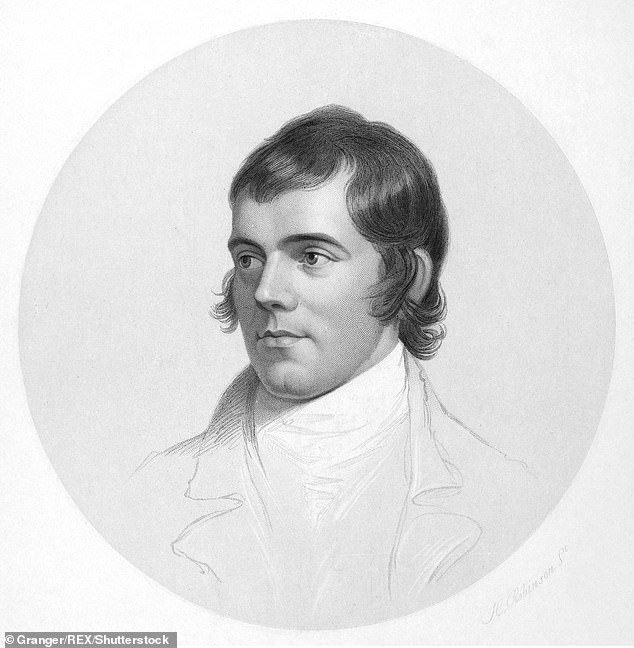Burns Night dinner is TWICE as bad for the environment than the average meal
>
Tonight, Scots around the world will feast on haggis, neeps and tatties to celebrate the birthday of Robert Burns, the 18th century Scottish poet.
But according to experts, the Burns Night staple – described as Scotland’s national dish – is twice as bad for the environment than your usual dinner.
Haggis, neeps and tatties has a carbon footprint of 3.4kg CO2 equivalent (CO2e), double that of an average meal served in the UK, they say.
However, vegetarians and vegans can chow down guilt-free on their plant-based haggis tonight, as its carbon footprint is well below the average.
Haggis is normally made with sheep offal, but originally any animal would have been used. It’s typically served with ‘neeps’ (swede) and ‘tatties’ (potatoes)
The analysis was provided by Swedish food start-up Klimato, which measures and tracks the different carbon footprints of food and drink.
According to the firm, the average UK meal has a carbon footprint of 1.7 kg CO2 equivalent (CO2e), which is a unit of measurement that is used to standardise the climate effects of various greenhouse gases.
Traditional haggis, neeps and tatties is twice this (3.4kg CO2e) while the plant-based version is much lower (0.6 kg CO2e).
Haggis – which has been banned in the US since the 1970s – is a savoury pudding composed of the minced sheep’s offal (liver, heart, and lungs) mixed with oatmeal and and spices.
It’s traditionally served with ‘neeps’ (swede) and ‘tatties’ (potatoes), but the haggis portion of the meal is what drives its carbon footprint up.
This is because livestock farming at scale pumps out vast quantities of CO2 and methane, an even more powerful greenhouse gas.
Vegetarian haggis has increasingly become a fixture of the supermarket shelves in recent years, due to the transition to plant-based diets.
Instead of offal, it usually contains a mix of vegetables and pulses, along with the usual spices and seeds to resemble the dark offal chunks.
Although an average UK meal has a carbon footprint of 1.7 kg CO2e, this number needs to go down below 0.5 kg CO2e to reach the goals of the Paris Agreement, Klimato says.

Scots around the world will celebrate Burns Night today (January 25) in celebration of the life and poetry of poet Robert Burns. The haggis was famously described by Burns as ‘Great chieftain o’ the pudding-race’ in 1786
Adopted in 2016, the Paris Agreement aims to hold an increase in global average temperature to below 2°C (3.6°F) and pursue efforts to limit the temperature increase to 1.5°C (2.7°F).
Klimato works to encourage restaurants to add carbon footprint labels to their food options so diners can make eco-friendly choices.
The firm calculated and displayed carbon footprint labels for the official menu at COP26, the UN’s climate change conference, in Glasgow in autumn 2021.
The labels aimed to encourage people to choose the more eco-friendly options, although it didn’t stop the more meat-heavy high CO2e options from being offered.
In fact, COP26’s official menu was slammed as being ‘like serving cigarettes at a lung cancer conference’ because it was full of high-emissions meat and diary from Scottish farms.
As well as haggis, neeps and tatties, the vast selection of COP26 menus included Scottish beef burger, smoked chicken pizza and braised turkey meatballs.
Also included were low CO2e options such as Scotch barley broth, vegetable hot pot, wholegrain pasta and a selection of salads.

Pictured, one of the menus at COP26, the UN’s climate change conference, in Glasgow in autumn 2021, complete with carbon footprint labels
The origin of haggis is uncertain, and the derivation of the term haggis, first attested in the 15th century, is unknown.
It was famously described by Burns as ‘Great chieftain o’ the pudding-race’ in his 1786 poem ‘Address to a Haggis’.
However, feathers were ruffled several years ago when a Scottish food historian Emma Irving claimed it was created by the English.
Irving said the first recipe for haggis was actually found in Lancashire in 1430, under the name ‘ hagws’ or ‘hagese’.
Though regarded since the mid-18th century as a distinctively Scottish dish, it was long popular in England, as English writer Gervase Markham testified in his 1615 book ‘The English Huswife’, more than 150 years before it was popularised by Burns in his poem.
Its origin, however, is still more ancient, as ancient writers Marcus Apicius, Aristophanes and Homer allude to dishes of similar composition more than 1,000 years ago, according to Encyclopaedia Britannica.
